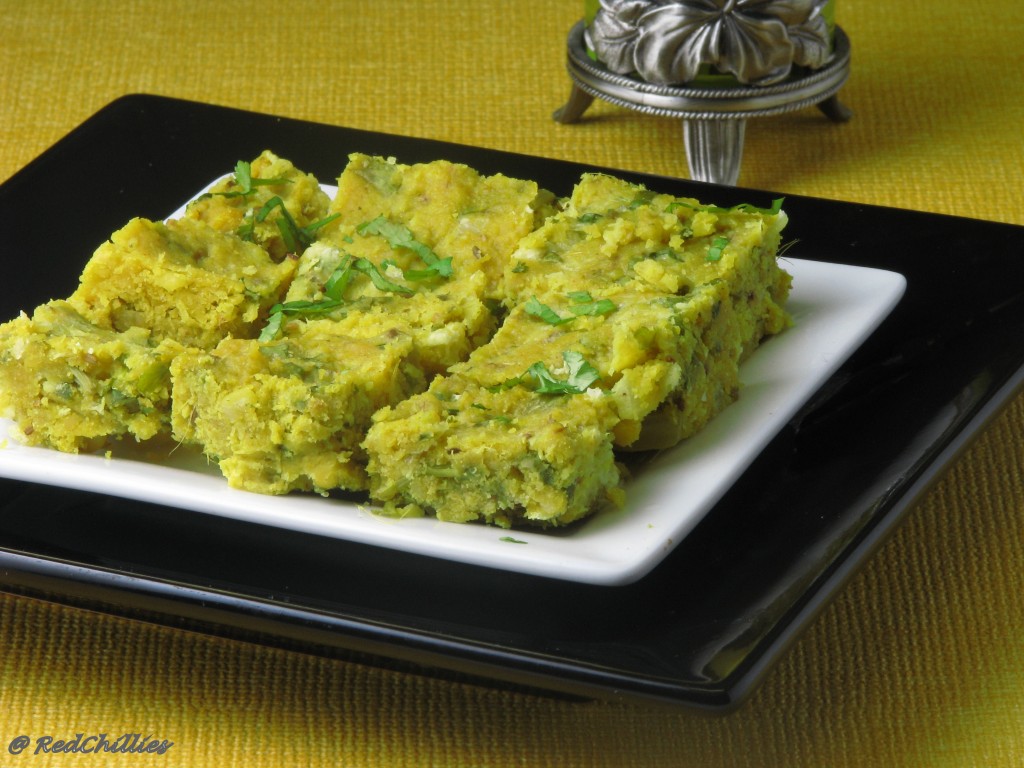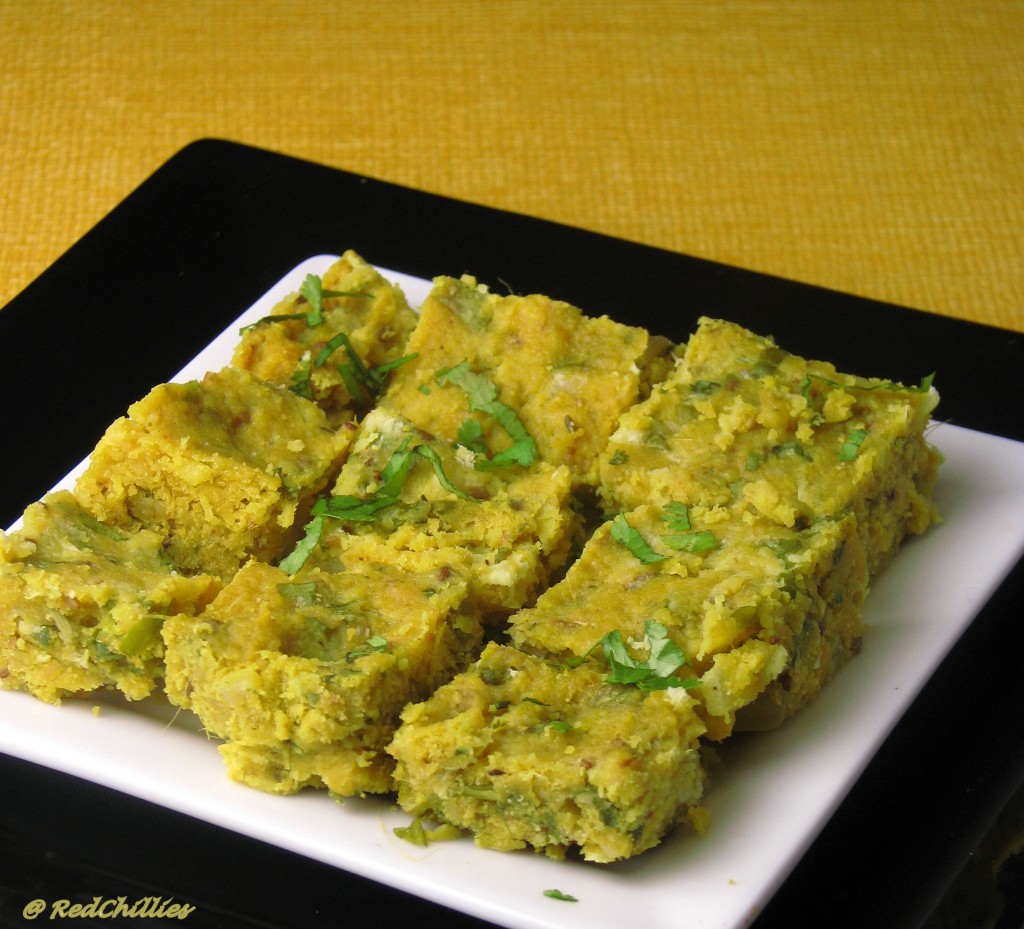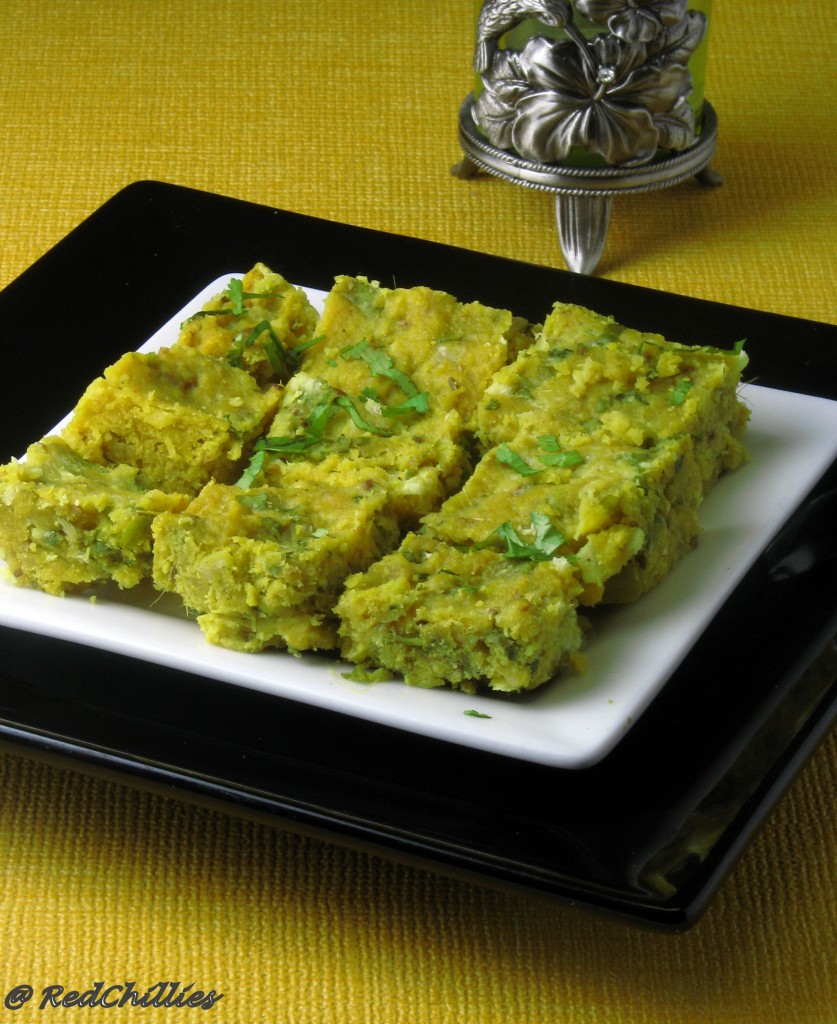Steamed Spiced Multi-Lentil Squares

OK, I have to admit this, before I go on with the recipe. I do not know the traditional name of this dish; all I know is that it is a dish from Karnataka. The English title that I put more descriptive of the procedure, seems so formal and does not seem to have that connection with the dish. If somebody knows the name please let know.
Many years ago my mom had learnt this from one of our neighbor “Uma Aunty”. She was an ace cook who could whip delicious dishes in no time. Many a times she would send over some of her dishes to us and we would enjoy tasting it. This is one such dish, but unfortunately I do not remember the name of this. She used to say that, this is usually served to people recovering from an illness. Not only in this healthy, low-fat but also caters to their lost taste and appetite.
During the process of writing this post, it stuck to me that this dish is more like a distant cousin of nucchina-unde. The ingredients are mostly similar; the procedure of steaming is the same, the difference being that in this case the daal mixture is steamed as a whole, instead of steaming each ‘unde’ separately as in nucchina-unde.
I do not prepare this often as most of them in my family are not huge fans of this dish; I am the only exception though. Don’t be worried by the long list of ingredients, most of the items are used for grinding and act as taste enhancer. Daal mixture when steamed tends to taste bland and so most of the ingredients are used to kick it up by a notch J Nevertheless it is easy to prepare, rich in protein and nutritious as well.
If interested you can check out another version of steamed daal that I posted long time ago, here Steamed Toor Daal Dill Cake.

Ingredients
- ½ cup Chana Daal/ Bengal gram dal
- ½ cup moong daal
- 1 medium onion
- Handful coriander leaves
- 1 cup packed Fresh Methi leaves (strongly recommend this)
- 2 green chillies
- 1 inch ginger piece
- 1-2 curry leaves
- ½ tsp turmeric
- 2 tsp Jeera/ cumin seeds
- Salt to taste
- Cinnamon, cloves
- 1 Tbsp shredded coconut
- 1 Tbsp Oil

Preparation:
- Soak the chana daal, moong daal in enough water for about 5-6 hours.
- Chop the onions into small pieces and keep aside.
- Clean the Methi(Fenugreek) leaves, coriander leaves and chop finely.
Method:
- First grind Jeera (cumin seeds) along with green chillies, curry leaves, ginger, turmeric, salt and cloves and cinnamon. Do not add any water.
- Note: Some people do not like the taste of bits and pieces of cloves and cinnamon. If so do not add them while grinding, instead make fine powder separately and add it to the ground mixture.
- Now drain the water completely from the soaked daal and add this to the ground mixture on step 1 and grind it again. Do not add water while grinding.
- Note: Sometimes the mixer blade might not move at all, in that case sprinkle little bit of water in between. This should be a thick paste and if you make a ball out of it, it should retain its shape without crumbling.
- Make sure that the salt and the chillies taste is correct. Go a tad bit higher on the salt and chillies, as it tends to get bland after it is steamed.
- Add the diced onions, oil, turmeric, coriander leaves, coconut and methi leaves and mix well.
- Heat a pressure cooker with enough water. Grease a container and pour the ground daal mixture into it.
- Place in the pressure cooker (with water) and cook until 2 whistles.
- Cool and cut into squares before serving. This can be used as a yummy side dish or can be eaten as is.
- Optional: You could season these squares just like you would do for a Dhokla.

yummy dish.. N sooo healthy too. I love dishes like this
Thanks deepthi, glad you liked it.
Sounds more like Dhokla but there are different ways to do that too… I am not sure what this is called in KArnataka!!! Shall check with my friend!!! But the lenthil squares looks so tempting and nice pic!!!
Thanks Ramya. Do let me know if you find out.
lOOKS similar to “bele idlies”, like the flavor of methi with it, very nutritious.
Thanks Madhu, yes indeed. If we steam the batter in idli containers then these can be termed bele idlis.
Each little squares looks so cute and nice … Fantastic click asusual.
Thanks so much Pavithra, glad you liked it.
Great idea. Do you need to put water in the pressure cooker first?
Thanks Mallika. For some reasons I thought you could read my mind :-). Yes you need to put water in the pressure cooker. I will add this to the post.
They look so perfect like Dhokla’s.Love the way u have clicked
Thanks so much Soumya. Glad you liked it.
Heathy lentil squares, neat clicks!
Thanks Sharmilee.
Nice pictures. This is just a modified nucchina unde. Traditional Nucchina unde doesn’t have onions (at least in my mom’s place) and no clove or cinnamon. Apart from that I don’t see any difference except in the shape of it. But, I like this presentation better than undes.
thanks Champa for the information. So glad you think that this is a modified nucchina unde
Bengalis make something like this called the Dhoka (Sandeepa has posted it) … only the paste is cooked and fried. But what is in a name RC when you have such a delicious looking thing to munch on! 🙂
Love the idea of methi in it.
Thanks sharmila, cannot agree with you more. What is in a name Dhokla/dhoka/ Nucchine Unde as long as it tastes delicious right 🙂
Wat a healthy dish to enjoy without any guilt, looks delicious!!
True Priya and as a bonus it is healthy too.!
This is fantastic recipe Supriya! Thanks a ton for sharing, its so healthy and I am sure it would be fulfilling as well 🙂 Let me see if i can make them on this weekend, will let u know, thanks once again!
Thanks Parita. Let me know how it turned out 🙂
Lets call it chana and moong dal dhokla bcos its made the same way as Gujrati “Dhokla”
Awesome, I think I like the name already 🙂 .Thanks for sharing the receipe for Methi Dudhi delight! Will give it a try sometime
substitute moong dal with grated bottle gourd (dudhi) and chana dal with gram flour (besan) and follow the same procedure as above. Its called “Methi dudhi delight”
Looks like a Dhokla…nice click..!!
True, after I season it, it is all dhokla. Yumm!
They look so good. I bet most of the lentil ball kuzhambus get made spicy and tangy because the balls themselves like you say become bland.
Thanks ISG. Cannot agree more.
Very interesting recipe. Reminds me of Dhoka that we do in Bengal. (we cook the cakes in gravy then). These must have been really good with all the herbs and spices in them.
Thanks Soma. I am so intrigued that each region has a name for this one (albeit some variations in spices). this tastes good, more like a spicer version of Dhokla
Hi,
What you have is half recipe of a south Karnataka specialty called Kara Kadubu. This is prepared during Ganesha festival. Outer cover for this steamed dal mixture is rice crepe. Some people prepare this without the crepe but original recipe is Kara Kadubu with Rice layer.
Hope this helps you to give it the authentic name 🙂
Thanks
Punita
Thanks Punita for the info. We love both Khara and Sihi kadubu at home. But I did not know that some people only made the inner filling without the outer rice crepe. Interesting!
Very interesting recipe, Should be very fulfilling!
Thanks Cham, it is indeed fulfilling
Oh these look great! Yum!
Thanks Sook. Glad you liked it.
Love the look of those!
Thanks a bunch Nags
We usually steam masala vadas for vada curry like this before putting it into the gravy – and it tastes amazing when soaked.
Miri, they are like steamed masala vadas aren’t they? The idea of transforming this into a curry is very interesting.
I would be sure to enjoy this! I’ve not thought of making anything like this, but I am very curious to try. I recently made your methi mung curry and will be posting about it soon. Thanks for all of your tempting recipes.
Thanks so much Lisa. Coming from you, it means a lot to me. Do give this a try. Glad that you liked the Methi moong daal, cannot wait to see your version.
Reminds me of dhokla, not sure what it is called though ! This looks delicious, would love to try it !
Wow!!! this is such a healthy recipe!!! looks great too:) yumm!!!!!
Tat was so nice of u to comment again, I m touched RC!! 🙂
Looks a lot like dhokla but the texture seems a bit different.
Interesting; never seen this before.
The squares resemble dhokla a lot except that they aren’t porous….nice presentation:)
Hi Supriya,
Thanks for sharing this recipe. As I was on a protein diet, I made it.. unfortunately I did not like it as much..I think it is because I steamed it for longer. But I think it is a brilliant idea.. you know it reminded me of dal vada (all the ingredients except methi goes into dal wada). ..so it is like steamed dal wada…low fat dal wada.. you are the queen of low fat cooking.. 🙂
Thanks,
Anu
Thanks Anu for the kind words and also your feedback. I am sorry that this did not turn out as expected. Hope there was no water while grinding the mixture. But then there is always a next time isn’t it?
Supriya
Now I know, this is the one that is a lot like the Dhoka I make. I will try steaming next time.
Hi Supriya!! Lovely recipe and clicks!!Is this called “hittina Palya’ by any chance?? Something similar is made in North karnataka and is eaten with chapatis. Remember the yummy taste…
Thanks for the information Suma. I did not know about Hittina Palya at all. But is that steamed or made like a regular palya? DEfinitely worth a try.
Pretty nice post. I just stumbled upon your blog and wanted to say that I have really enjoyed browsing your blog posts. In any case I’ll be subscribing to your feed and I hope you write again soon!
I recently subscribed to your newsletter and took the time today to browse. I do not have a pressure cooker and don’t know the other dishes or how they are prepared. There is a dish that originated in the Southern US (I am a Canadian vegetarian and love to try ethnic dishes – especially hot, spicy ones!) called polenta that looks similar – similar colour, shape and blandness without spices. It is made with cornmeal which is boiled on the stove and then baked. Could your recipe be baked? I will be returning to your site often and also following leads that you and your reviewers give.
Hi…it looks yummy….my mom makes this and she adds dill leaves too…and she steams in idli stand….and she calls it as masala idli…
As suma said, its not Hittana palya( called Junuka), used in North Karnataka.
Ahh… I did not know these were called masala Idlis. I just season the regular old idli batter and make idli and call them masala Idli 🙂
Hi,
Your blog has lot of interesting recipes. I wanted to try steamed-spiced-multi-lentil-squares. Does this recipe not require any baking soda/powder or fruit salt since all other dhokla kind of recipes ask for it?
Also, what is the texture of the end product(sticky or grainy)? Thanks in advance.
Hi Raji,
Thank you. The original recipe does not call for baking powder/soda, hence this will not be soft and fluffy. The end product will be little grainy (provided the batter is not too watery and pastey) 🙂 Hope this helps.
Thanks for your quick reply. I will try.
We make small elongated balls of it and serve with tambuli. It is called ‘togri nuchinna unde’ in kannada.
That is good to know 🙂
yup, this is like the traditional Madhwa Nuchina unde, we make thi during Ganesha Habba, sans onion, garlic of course
It is called ‘MUTHIYA’ in Gujarati. Instead of onion, we put garlic and omit clove/cinnamon. It is similar to dhokla but it is not dhokla, it is closer to muthiya.
This is an authentic dish of Karnataka called ‘Nucchine Unde’
Thanks Seema.
woow what a perfect “Zunka wadi”…its called so in our North Karnataka..I m from Hubli..my Mom usually does this..& we eat them with chapathi & jolada rotti..
Your pic looks great & looks yumm..
Should try once..
Zunka Wadi is made from Besan, so this is not that.
It is made more in south karnataka more like coorg, sakleshpura side
it is called kadabu, you can also call it kadlebele kadabu (anything steam cooked other than idli is called kadabu)
I grew up in North karnatak but mom is from coorg so we made these at home often
looka like wadi, but maybe diff name…thanks for recipe, wonderful website. Keep up this good work.
Looks like seeralam (tamil) to me! We used make it using adai batter. This one does not have rice and has fenugreek leaves. That’s the difference. Will make it for my little one!
I liked the recipe. I’ll try this without fail. My son would like this dish